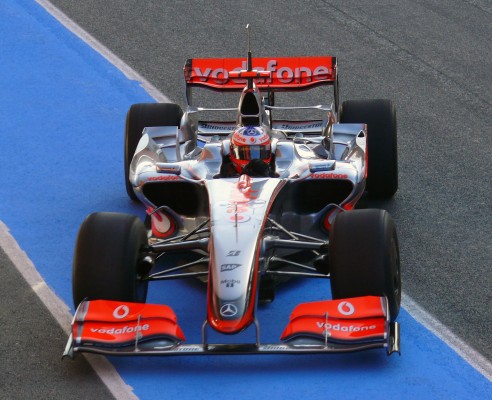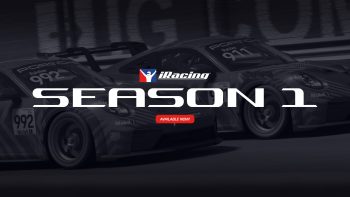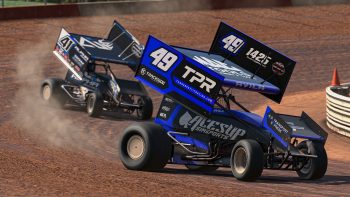
Behind the Scenes: The NASCAR PEAK Antifreeze Series powered by iRacing.com – New Build, Same Plan
March 12th, 2015 by Jaime Baker
A few weeks ago, I had a chat with an old friend. He’s an old “iRacing buddy” of mine, one of the big-wigs at the team I was part of before joining Gale Force Sim Racing. The two of us are great examples of how iRacing has developed its own types of members, very similar to how the real world of motorsport works. He is from the northern US, and Modified Stock Cars and weekly short-track racing is his deal. I am from the Carolinas, where engineering, math, and wind-tunnels have taken over the world of NASCAR. His iRacing vehicle of choice is obviously the Modifieds, and he calls the big stock cars “Taxi cabs.” I, however, have no real vehicle of choice, and haven’t run anything on a week-to-week basis in years. I have research and testing to do, racing just takes up time!

Even this race in a Super Late Model at New Smyrna wasn’t because I wanted to race. That would take up too much time!
Because of the differences in how we perceive circle track racing, we always get into discussions that are basically two bulls in a china shop, but they’re very interesting conversations nonetheless. He was complaining about how he has to rebuild all his setups every season from scratch, and he mentioned how annoying that is. I asked, “Why are you starting from scratch?”, to which he didn’t have an answer to. Well, he did, but Mr. Phillips will get mad at me if I write it into an article, so for all intents and purposes, he had no answer.
It got me thinking though, and I started wondering if that’s how everyone works in the sim-racing world. In this little cave that I call my “office” at GFR, I don’t pay attention to how other people in sim-racing work, and I’ve always used methods and principles that exist in real-world motorsport. This subject came up again when the new build was pushed to Wednesday instead of the typical Tuesday because of the NASCAR PEAK Antifreeze Series race at Las Vegas. There was a big discussion about how everyone was upset over this. To be honest, I’ve expressed my displeasure over the build delay on teamspeak multiple times this week by saying, “You guys need to hurry up and get this race over with. I want Monza.” I digress. One of our drivers, Brian Day, actually posted a comment that caught my eye:
“The turnaround time to totally re-build a setup in a few hours time is not obtainable…”
While this comment is not wrong at all, many of you will agree on this, it did take me back to the discussion I had with my friend a few weeks back. I asked a few people on our team about it, and they all said that they typically start from scratch with a new build. When I asked why, they all replied, “Well it’s a new build. I have to start over.”
But why is that the case? Why has this become a “thing” that happens with new builds? (There’s an inevitable risk of tooting my own horn with this, but this is supposed to go “behind the scenes”, and maybe it can help others to avoid weeks of hair-pulling and hopefully lead to some better racing. By no means is it an attempt at yelling “My way’s the right way, bow to meee!!”, everyone has their own way of doing things, this just happens to work for me.)
We have this new build coming Wednesday, and while I was writing this article the build notes were posted and showed how much of an undertaking the next few days will be for all of the NASCAR PEAK Antifreeze Series teams. We have new aero, new engine, bumpstops are being tossed out for secondary springs, and suspension components will now flex! Personally, I’m excited about it. Everyone else seems to be dreading it.
For me, and the “research department” at GFR, this build will be no different than any previous build. I have a car built right now that has been on the Las Vegas Motor Speedway for the past three weeks with a setup that is consistent, balanced, and responsive. It is not what is in the NASCAR PEAK Antifreeze Series cars, however. Just like with every other build, when the build is released and everything’s been updated, I’ll simply load that setup into the “new” car and run it. Yes, it will likely drive very differently on Thursday than it did on Monday, but every new problem or “feature” it has on the new build will tell us all what really changed with the build, and what needs to be changed. Build notes are a great start, but they don’t really tell you how much they actually changed each thing. If history is consistent, I will likely have the car back to behaving properly by the weekend, not to mention have a loaded notebook on how to set up the car for the new build. Then, when the next build rolls around in three months, I’ll do the same thing again.
Yes, that’s right: I start every new build on the setup that I ended the last build with. Obviously, there are some things that have to be adjusted slightly such as ride heights, preload torques, etc., but the first setup in the new build is basically what I finished with on the previous build. It’s also the busiest time for telemetry readouts, as that’s the best way to see how things have changed. Does the car settle differently under at-speed downforce loads? Has wheel travel speed changed with the same spring rates? Does the car respond in the same way to this adjustment? Does alignment gain/loss still work the same way it used to? If you get an answer to all of those questions, you’ve basically gone over how the car changed, so you can make your adjustments to compensate.

This was the last car that I set up for testing in the Impala “COT” vehicle, the one mentioned in the article.
A prime example of where this worked was in 2013 when we got the Chevrolet SS “Gen-6” car on the service. Similar to what I mentioned above, I had a setup built on the Chevrolet Impala COT car that was built with the Gen-6 car in mind (it had no rear sway bar, for instance). Once the build was released, I loaded that setup into my Chevrolet SS and hit the track. Unsurprisingly, it actually did “hit” the track, but not much was very different. Yes, the power was different, aerodynamics were different, but the first few races of the 2013 NASCAR PEAK Antifreeze Series had the #05 car of Nick Ottinger running on a setup that was incredibly similar to the setup he ran in the 2012 season on the “COT” car. In fact, the car that he won the Texas race in was almost identical to what was run in the 2012 season.

And this was the first car I set up for Gen-6 testing. Believe it or not, the #55 pictured here had the same setup as the car in the Las Vegas COT picture above.
This way of handling new builds and software updates is rather foreign to the sim-racing world, but it’s how teams in the real-world handle regulation changes. Regardless of what series you’re a fan of, it’s very possible that your series-of-choice went through a drastic swing of rule changes in the past few years. NASCAR had their Gen-6 rollout only a few years after their COT rollout. Now we’re seeing a big change in both aerodynamics and power plant regulations. Formula 1 had their enormous aerodynamic update in 2009, followed by a change in pit-stop regulations making the cars longer, then last year they completely overhauled the power units. Even endurance racing has gone through major changes in the past few years, with LMP1 prototypes going to exclusively closed-cockpit vehicles and hybrid drive systems. All these changes were huge, but ask any of these teams and they’ll all tell you the same thing: We started on the new cars using what we knew from the previous years.
The NASCAR COT landed in Bristol in the spring of 2007, and, while it was drastically different from the Generation 4 cars, teams all admitted that they were using setups from way back in the day, and based on how the cars looked on track, that was very clear. Eventually, the COT became a car that was set up exclusively for aerodynamics, and the attitude it had on track in 2012 was mirrored by the Generation 6 cars in early 2013. I remember going to one of the first tests at Charlotte for the new car in 2013, and, since all the cars were painted flat gray, they really didn’t behave much different than the COT cars I watched at the All-Star race the previous year. Similar setups? Very likely, but now those setups have evolved to take advantage of what the new car can offer. The same will happen with the 2015 rule changes.
When the Generation 6 cars were finalized, we started seeing them on-track during 2012 tests. I specifically remember the test at Kansas, when Clint Bowyer took a relatively un-decaled Toyota Camry out on track and ran around other cars. While they probably did take some information for setup purposes, those runs were more than likely intended to see how differently the car behaved in traffic. They knew what happened to the COT when it was in dirty air behind another COT, so replacing the #15 COT with the #15 Gen-6 car would be a window into how different the car behaved in traffic, and show the teams what needed to be changed, if anything.

Clint Bowyer tested the Gen-6 Toyota Camry at Kansas in 2012, and unsurprisingly stayed close to a “COT” car through almost every run.
Formula 1 is known for constant updates being applied to the cars. The cars we see at the first Grand Prix in Australia this week will be, basically, boats compared to the cars that arrive in Texas later in the year. Nico Rosberg, of Mercedes F1, said, “The rate of development is impressive. If we take the race car from Melbourne and the race car from the end of the season, and they go against each other, the [car from the] end of the season will literally be one second, per lap, faster.” That’s astounding, but then we look at the recent pre-season tests in Barcelona, where Nico managed to run just over 2 seconds faster in testing than his teammate Lewis Hamilton ran in 2014 qualifying. So their 2015 car is a brand new car, but still faster than the all-conquering W05 from 2014. Even if we look at end-of-year testing for Formula 1 teams, they’re always taking next-year-spec parts and bolting them onto their current car. Why? Because they know how their current car works, and changing only one part will show what that specific part does. Anyone remember Lotus trying out a 2015-spec nose in Texas last year? Or what about when McLaren bolted their 2009 front wing onto the 2008 Championship-winning MP4-23? It’s simply because there’s no reason to start from scratch when you have something that you already know works properly.

A common sight at year-end Formula 1 tests: Last year’s car with this year’s gear. Here, McLaren bolted a 2009-spec front wing onto their 2008-spec car.
Geoffrey Willis, the Technology Director of the Mercedes F1 team said something last year that I really thought would be applicable to this:
“The first step in new car design is always to take, as a basis, the previous year’s design. Even if there’s a substantial change in regulation, you’re trying to use what you’ve used in the previous year’s design.”
So give it a shot with this new build: Take what you had in Season 1, try it out in the Season 2 build. Trust me, it’s not going to work as well as it used to (or it might be better, who knows?), but if you really pay attention to what it’s doing that was different from the previous season, you’ll already be one step ahead of those who took all their good information and threw it away simply because the button changed from “Race” to “Download Required”.














































